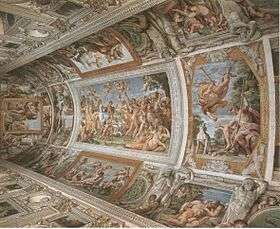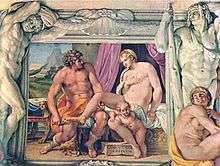The Loves of the Gods

The Loves of the Gods is a monumental fresco cycle, completed by the Bolognese artist Annibale Carracci and his studio, in the Farnese Gallery which is located in the west wing of the Palazzo Farnese, now the French Embassy, in Rome, Italy. The frescoes were greatly admired at the time, and were later considered to reflect a significant change in painting style away from sixteenth century Mannerism to anticipation of the development of Baroque and Classicism in Rome during the seventeenth century.
Production
Cardinal Odoardo Farnese, Pope Paul III's nephew, commissioned Annibale Carracci and his workshop to decorate the barrel-vaulted gallery on the piano nobile of the family palace. Work was started in 1597 and was not entirely finished until 1608, one year before Annibale's death.[1]
His brother Agostino joined him from 1597–1600, and other artists in the workshop included Giovanni Lanfranco, Francesco Albani, Domenichino and Sisto Badalocchio. The Farnese Gallery consists of profusely decorated quadratura and framed mythological scenes.
Scheme
Annibale Carracci had first decorated a small room, the Camerino (1595-7), in the Palazzo Farnese with scenes from the life of Hercules; the theme was probably selected because of the famous ancient Roman statue, known as the Farnese Hercules, which at that time was also in the Palazzo Farnese.[2] In 1597, he began to decorate the Gallery with mythological themes set within painted frames (quadri riportati) painted on an illusionistic architectural framework referred to as quadratura . Ignudi or painted nudes, putti, and herms help support the painted framework. Gian Pietro Bellori, a famous biographer of artists' lives of the next generation, called it 'Human Love Governed by Celestial Love'.
In the center panel, the ‘Triumph of Bacchus and Ariadne’ depicts a both riotous and classically restrained procession which ferries Bacchus and Ariadne to their lovers' bed. Here, the underlying myth is that Bacchus, the god of wine, had gained the love of the abandoned princess, Ariadne. The procession recalls the triumphs of the Republican and Imperial Roman era, in which the parades of victorious leaders had the laurel-crowned ‘imperator’ in a white chariot with two white horses. In Carracci’s procession, the two lovers are seated in chariots drawn by tigers and goats, and accompanied by a parade of nymphs, bacchanti, and trumpeting satyrs. At the fore, Bacchus' tutor, the paunchy, ugly, and leering drunk Silenus, rides an ass. The figures carefully cavort in order to hide most naked male genitals.[3]

The program refers to Ovid's Metamorphosis (VIII; lines 160-182) and the spirit alludes to contemporary images voiced, for example, a trifling carnival song-poem written by Lorenzo de Medici in about 1475, that entreats:
| Quest’è Bacco ed Arïanna, | Here are Bacchus and Ariadne, |
| belli, e l’un de l’altro ardenti: | Handsome, and burning for each other: |
| perché ’l tempo fugge e inganna, | Because time flees and fools, |
| sempre insieme stan contenti. | They stay together always content. |
| Queste ninfe ed altre genti | These nymphs and those others |
| sono allegre tuttavia. | Are ever full of joy. |
| Chi vuol esser lieto, sia: | Let those who wish to be happy, be: |
| di doman non c’è certezza. | Of tomorrow, we have no certainty. |
Legacy
|
|
Annibale Carracci's decorations in the Farnese Gallery demonstrated a new grand manner of monumental fresco painting.[5] They exerted a powerful formative influence on both canvas and fresco painting in Rome during the seventeenth century. The dual classicizing and baroque tendencies in this work would fuel the debate by the next generation of fresco painters, between Sacchi and Pietro da Cortona, over the number of figures to be included in a painting.[6] Carracci's treatment of the composition and the disposition and expression of the figures would influence painters such as Sacchi and Poussin, whereas his effervescent narrative manner influenced Cortona.

Annibale Carracci, in his day, was seen as one of the key painters to revive the classical style. In contrast, a few years later, artists such as Caravaggio and his followers would rebel against representing spatial depth in colour and light, and introduce tenebrous dramatic realism into their art instead. But it would be inappropriate to view Annibale Carracci as solely the continuation of an inherited tradition; in his day, his vigorous and dynamic style, and that of his studio assistants, changed the pre-eminent style of painting in Rome. His work would have been seen as liberating for artists of his day, touching on pagan themes with an unconstrained joy. It could be said that while Mannerism had mastered the art of formal strained contraposto and contorsion; Annibale Carracci had depicted dance and joy.
Later followers of Neoclassic formalism and severity frowned on the excesses of Annibale Carracci, but in his day, he would have been seen as masterful in achieving the supreme approximation to classic beauty in the tradition of Raphael and Giulio Romano's secular frescoes in the Loggia of the Villa Farnesina .[7] Unlike Raphael, though, his figures can display a Michelangelo-esque muscularity, and depart from the often emotionless visages of High Renaissance painting.[8]
Visiting the Farnese Gallery
To visit the gallery you must schedule a free appointment by phone or mail with the Servizio Culturale, French Embassy, Piazza Farnese 67, Rome 00186, Italy, Phone: 06-686011. Indicate when you wish to visit and provide a local phone number to receive confirmation a few days prior to your visit.
Panels of Farnese Ceiling




- Central Ceiling Fresco
- Triumph of Bacchus and Ariadne
- Ceiling Scenes
- Jupiter and Juno
- Diana and Endymion
- Hercules and Iole
- Venus and Anchises (father of Aeneas) (GENVS VNDE LATINVM)
- Medallion with Apollo and Marsyas'
- Medallion with Cupid and Pan'
- Medallion with Boreas and Orithyia'
- Medallion with Orpheus and Euridice'
- Medallion with Pan and Syrinx'
- Medallion with Salmacis and Hermaphroditus'
- Medallion with Europa and the Bull (Jupiter)'
- Medallion with Hero and Leander'
- Medallion with a scene of abduction
- Medallion with Jason and the Golden Fleece'
- Medallion with Paris'
- Medallion with Pan'
- Aurora and Cephalus
- Venus and Tritone, a.k.a. Glaucus and Scylla
- Polyphemus in Love
- Polyphemus in Anger
- The Rape of Ganymede by Jupiter as an Eagle and satyrs
- Apollo and Hyacinthus
- Pan and Diana
- Mercury and Paris
- Triumph of Bacchus and Ariadne
- Wall Scenes
- Fortitude
- Temperance
- Justice
- Charity
- Perseus and Andromeda
- Combat of Perseus and Phineas (turning followers to stone using the head of Medusa)
- Heraldic shield of Cardinal Alessandro Farnese
- Heraldic shield of Duke Alessandro Farnese
- Heraldic shield of Cardinal Odoardo Farnese
- Heraldic shield of Duke Ranuccio Farnese
- Virgin with the Unicorn
- Dedalus and Icarus
- Diana and Callisto
- Metamorphosis of Callisto into a Bear
- Mercury and Apollo
- Arion the Citharist is rescued by Dolphins
- Minerva and Prometheus
- Hercules slays the Dragon
- Hercules liberates Prometheus
Gallery
-

Diana and Endymion - Annibale Carracci - 1597
-

Hercules and Iole - Annibale Carracci - 1597
-

Venus and Anchises - Annibale Carracci - 1597
-

Paris and Mercury - Annibale Carracci - 1597
-

Pan and Diana - Annibale Carracci - 1597
-

Aurora and Cephalus - Agostino Carracci - 1597
-

Glaucus and Scylla - Agostino Carracci - 1597
-

Polyphemus Innamorato - Annibale Carracci - 1597
-

Polyphemus Furioso - Annibale Carracci - 1597
-

Hyacinth Borne to the Heavens by Apollo with satyrs - Annibale Carracci - 1597
-

Hercules Freeing Prometheus - Lanfranco - 1597
References
- ↑ When the Farnese frescoes were nearly complete, Cardinal Odoardo paid him an insultingly small sum of 500 scudi d'oro or pieces of gold which were brought to his room on a saucer. Annibale, physically exhausted after his work on the vault and profoundly upset by his brother Agostino's defection, reacted sharply to his patron's callous and ungrateful behavior and fell into a state of depression, lasting until his death in 1609.
- ↑ Thomas Hoving, later director of the Metropolitan Museum of Art, wrote his PhD on the cycle, pointing out many correspondences between the frescoes and items in the famous Farnese collection of Roman sculpture, much of which was then housed in the Gallery and now at the Capodimonte Museum in Naples. His suggestion that many details of the frescoes were designed to complement the marbles below has been generally accepted.
- ↑ The painter's cousin Ludovico Carracci engraved uncensored versions in prints of the scenes. Also, in contrast to the ceiling's intimation rather than outright depiction of mythological lovemaking, there are erotic engravings by the painter's brother Agostino - the I Modi.
- ↑ "Carracci's Ceiling of the Farnese Palace". Smarthistory at Khan Academy. Retrieved December 21, 2012.
- ↑ Wittkower, Rudolf. Art and Architecture in Italy 1600-1750, Pelican History of Art, 1985 edn., p. 57.
- ↑ This debate took place at the Accademia di San Luca, the guild for artists in Rome; see the article on Andrea Sacchi for more discussion.
- ↑ The Villa Farnesina was acquired by the same family, but built earlier for Agostino Chigi at the foot of the Janiculum Hill.
- ↑ It has been said that Carracci and his school blended Venetian colorism with the Florentine-Umbrian attention to drawing and design; yet this is best seen in the oil canvases rather than the frescoes in the Farnese.
Further reading
- Cajano, Elvira, and Settimi, Emanuela (eds.) (trans. John Adamson and Victoria Constable) (2015), The Carracci Gallery: Its History and Restoration. Dijon: Éditions Faton ISBN 978-2-87844-211-3 OCLC 944266919.
- Dempsey, Charles (2000). Annibale Carracci. The Farnese Gallery. George Braziller. ISBN 978-0-8076-1316-0 OCLC 31969918.
- Martin, John Rupert (1965). The Farnese Gallery. Princeton University Press. OCLC 523316.
External links
- Painting of the room with the fresco
- A paraphrased copy decorates the ceiling of the Blue Drawing Room at West Wycombe Park in England.